#Fresh chopped vegetables online
Text
Expert Advice on How to Handle, Wash, and Prepare Fresh Chopped Green Vegetables

It is common practise to use a number of pesticides and fertilizers to cultivate your green vegetables, some of which may be harmful if ingested. Therefore, always choose the right online cut vegetable delivery partner which takes care of your health and provides you the right vegetables.
In this article, you will learn some helpful tips for handling, washing and preparing fresh vegetables at your home.
Why Do You Need to Wash Your Vegetables?
Your consumption of fruits and vegetables exposes you to chemicals and pesticides that are hazardous to human health. Pesticides are mostly used during agricultural cultivation and occasionally as leftovers.
But there are a lot of pesticides in fruits and vegetables. The brain and reproductive systems are harmed, the immune system is compromised, and in rare situations, high quantities of chemicals and pesticides can even cause cancer.
Vegetables must be properly washed in accordance with safety precautions in order to prevent illness.
A thorough cleaning would also help to avoid ingesting numerous bacteria and insects that could have been growing in the green bunch. You still need to exercise caution to safeguard yourself from the dirt and bacteria that the greens picked up during handling, even if you order fresh cut vegetables from organic stores.
Precautions You Need to Take Care While You Order Fresh Cut Vegetables
Wash your hands completely before you begin cleaning. Before handling leafy greens, wash your hands with water and soap for at least 20 seconds.
Wash them under cold running tap water This goes for all greens, including spinach, kale, lettuce, broccoli, and cabbage. When greens are washed in hot water, they can quickly wilt.
Remove the outside/wilted leaves When eating vegetables like lettuce and cabbage, start by removing the outer leaves. Throw away any leaves that are rotting, withered, or discoloured if you discover any. Remove the rotten-looking section of the stem.
Rinse and drain Take the greens and give them a thorough wash in a colander, a dish with holes used in the kitchen to drain food. Drain any extra water. You may use a salad spinner to drain any leftover liquid. After that, blot them dry using a paper towel. Never use soap, detergent, or bleach to wash vegetables since they may leave residues that are harmful to eat. Before washing the vegetables, make certain the water is always pure and fresh.
Place the leafy greens in a sealed plastic bag in the refrigerator and cover with clean paper towels or a freshly washed kitchen towel. Use it within a week.
Take notice of this professional advice and wash your ordered online chopped vegetables completely to avoid consuming pesticides and other dangerous chemicals in the future.
While Cutting Precautions You Need to Take Care
Do you realize that your vegetable's nutritional content will also depend on the sort of knife you use? A research found that cutting your veggies with a dull knife might cause the loss of electrolytes like calcium and potassium.
In addition to producing properly chopped pieces, using a sharp blade will stop germs from growing on diced vegetables. It is believed that a vegetable loses more nutrients when it is cooked the finer it is sliced. The majority of us slice vegetables 1-2 hours before cooking, and during that time, the value of the finely chopped vegetables is lost.
For the purpose of preserving their nutrients, vegetables that have been finely chopped or shredded must be cooked right away. If you cut your vegetables hours in advance, use larger bits and pieces.
Endnote
One of the most crucial aspects of meal preparation may very well be learning how to wash veggies properly. After all, improperly cleaned or unwashed fruit might pose a risk to the safety of the meal being consumed. No matter how good your handmade cuisine may be, something can ruin it.
Vegetables can lose value even before they are cooked, while being a crucial component of a balanced and nutritious diet. Each of your actions—peeling, slicing, and even washing—helps to preserve the nutrients in your vegetables. Hope you receive the most health advantages possible from fresh chopped green vegetables.
#order vegetables online#fresh vegetable online#fruits and vegetables delivery in bangalore#Fresh chopped vegetables online#online chopped vegetables#buy fresh vegetable#online cut vegetable delivery
0 notes
Text
Buy Hydroponic Brinjal Online in Delhi NCR | Inhydrogreens

Hydroponic Brinjal is a rich source of dietary fibre hence promotes digestion. It helps in maintaining blood sugar and cholesterol levels. It contains phytonutrients which protects our cells from getting damaged and has strong anti-bacterial properties.
#Hydroponic Brinjal online#Green Basket#Hydroponic Salad Store In Delhi NCR#Hydroponics Vegetables Online#Hydroponics Store Near Me#Hydroponic Vegetables Stores in Delhi NCR#Buy Hydroponic Chives online#Buy Hydroponic Herbs Online#Buy Fresh Herbs Online#Mix Lettuce Box#Buy Online Microgreens Box#Buy Hydroponic Microgreens#Hydroponic Vegetables Online#Leafy Green Vegetables in Delhi#Fresh Herbs Online Delhi#Buy Chopped Vegetables#Chopped Vegetables Online
1 note
·
View note
Text
No Excuses



PAIRINGS: Simon "Ghost" Riley x Wife!Sri-Lankan!Reader
WARNINGS: HEAVY FLUFF, Simons a fucking simp for the missus, good food :)
SOME INFO: 'Avurudda' means 'New Year', and Kottu and Appa are some famous Sri Lankan traditional food
WORD COUNT: 1,484
ENJOY!
"Yes, Amma. Yes, I cleaned the house like you told me to," you confess softly to your Sri Lankan mother, a tender smile gracing your lips as you recall the gentle encouragement she always provided.
Avurudda season has arrived, a time when the essence of your Sri Lankan heritage fills the air with warmth and nostalgia. In homage to your roots, you meticulously prepared your home, ensuring every corner gleamed with the promise of new beginnings.
And with a sense of reverence, you sought out a traditional Sri Lankan lamp online, a beacon of light to guide you through the festivities of the new year
When you married Simon, Your parents hesitated, their reservations echoing the unspoken fears of marrying outside your culture lingered in your heart
Yet, can they really blame you?
You fell in love with the Lieutenant while you were a techie for one of the TF-141 missions. The mission was primarily automotive, so the team, especially Simon, heavily relied on you. You didn’t think that you had it in you to thaw the ice around the Lt’s heart, but to him, you were his solace, his light.
In the steady rhythm of time, Simon's heart quietly yielded to the gravity of your presence, each day etching deeper into the stone of his resolve, sculpting a silent monument to the unyielding strength of his love for you.
After a few tense debriefs, he finally had the courage.
From the tension of your first encounters to secret touches, which morphed into silent kisses behind closed doors. Your both grew needing the other, the love you have for him and him, you, just became heavier in the depths of your hearts.
Soon, you moved into his flat. And a year later, you’re sleeping next to the love of your life with a gold band on your finger and his last name after your first.
Your parents soon backed off when they realized how much Simon cared for you and you for him.
Your mother's voice breaks you out of your reverie.
"Have you seen the recipes I’ve sent you, the Kottu and the Appa ones?" Your Amma questions, and you tilt your head back and close your eyes. "Yes, Amma, I did. Haven’t I told you that already?"
-----
You hear the door open as you sauté some vegetables the way your mother said to, in her recipe.
"Love? Are you here?" you hear the gruff voice of your husband through the entrance hall of your home.
You holler that you’re in the kitchen.
With a gentle embrace, Simon enfolds you in his arms, his touch igniting a spark of warmth that spreads through your body like wildfire. You lean into his embrace, relishing the comfort of his touch as he buries his face in the crook of your neck, inhaling the sweet scent of your skin. "Hi, handsome," you whisper softly, your voice a tender caress that lingers in the air between you.
Simon grunts out a laugh and hugs you tighter, "missed you, love."
You both stand in silence, letting Simon take you in.
"Have you brought the things I asked you to?" you whisper gently, switching off the heat of the stove. Simon nods, "it was tricky to find them, but I managed to."
Simon finally releases you and goes to grab the paper bags from the table near the door and places them on the kitchen counter.
You smile at him and give a little squeeze to his bicep and dig through the bag. "Great, everything is here, thanks babe," you lay out everything and start to cook your Kottu. You start chopping up the fresh thin, soft rotti until it's the right size.
You feel Simon peek over your shoulder and then go back to the pot and get a whiff of the food you made already. "Jesus, love. It smells incredible," he leans against the kitchen counter watching you chop the last of the rotti and throw the shredded fine bread into your pot.
You inhale deeply, "well, it's Avurudda. Sri Lankan new year." You say sheepishly, as you throw a glance at your husband over your shoulder.
Simon’s eyes go wide and he nods slowly, "I see." He rubs a hand over his chin and takes in the information you just gave him. He pieces everything together and scolds himself for not remembering, "love, I'm sorry I didn’t know."
You chuckle and shake your head, "honey, it’s fine, really." Simon shakes his head, "I should remember my wife’s cultural holidays. No excuses, love." You pout at Simon beating himself up, "hey, I know what can make you feel better."
He looks up at you confused and raises a brow. "I bought a Sinhala lamp, could you help me set it up?" you smile at him as he nods eagerly before you finish your sentence. You give him the instructions and show him the package that came in this afternoon. "Alright, I’ll get on with it," he whispers, rubbing a hand on your lower back and kissing your temple.
You smile and finish your work in the kitchen.
-----
Simon sets the table and you plate the food.
Then you sit down to enjoy the meal you've prepared together, the flickering light of the candles casts a warm glow over the table, bathing you both in its gentle embrace.
Now he sits in front of you and looks at the crispy Appas and delicious looking Kottu sitting between the both of you.
"Alright, so. This is Kottu, it's basically pieces of thick paratha or rotti, cooked with veggies and shredded chicken. It’s my ultimate favorite dish," you point at the plate of food, and talk animatedly.
You don’t see the subtle smile on your husband's face as he sees you talk passionately, and he opens a file in his mind and files in the information that Kottu is your favorite meal. You then point at the crispy upside-down domes.
“These are Appas, or Hoppers, they are amazing with chicken curry," you point at the curry you made a little while ago, "alright that’s it, dig in! And, Suba aluth avurudak weva, mage rattaran.” Simon has learned a little Sinhala for you since you first got married, and he translates your words in his mind.
Happy new year, my darling.
-----
As you and Simon delve into conversation about your respective days, you both begin to enjoy your meals. With each bite, you savor the taste of home, the flavors of your heritage filling your senses with a sense of belonging.
You take occasional sips from a glass of wine, Simon leisurely drinks from a bottle of beer.
“It’s absolutely delicious, love,” he says, reaching for your hand across the table. He rubs his thumb on the delicate skin of your hand. You smile and say your thanks.
You meet his gaze, your eyes locking in a silent exchange that speaks volumes without a single word. And in that moment, as you sit together in the soft glow of the candlelight, you know that you are exactly where you're meant to be, with the man who holds your heart in his hands.
Your leg brushes against his ankle, the fabric of your sock gliding over his skin. Simon grins and gently clasps your limb, placing it tenderly on his lap. Your smile broadens as he begins to caress it, sending waves of comfort through you.
The atmosphere is filled to the brim with your love for each other, the only source of light is from the candles lit on the table and the traditional lamp next to your dining table.
Simon reflects on his fortune, marveling at the serendipity of finding a woman as remarkable as you. He finds solace in the thought of a love so deeply reciprocated, where every beat of his heart echoes with the resonance of your affection, intertwining your souls in a bittersweet symphony of devotion.
-----
You stir from slumber to the not-so-gentle melody of your phone's alarm.
Blinking away the remnants of sleep, you reach out to silence it, yearning for the familiar presence of your Simon beside you.
Yet, as you turn, you find only the empty space where he once lay, his absence palpable in the morning light.
With a soft exhale, you sit up, the soft rays of dawn casting a warm glow around you. It's then that your gaze drifts to his bedside table, where a bouquet of delicate pink and white tulips awaits, their petals kissed by the soft light of dawn.
Nestled among the blooms, a note written in his hand catches your eye.
It’s in his handwriting, the ink scratchy and blotchy. His sinhala words marking their spot on the hard paper.
A rush of emotion floods your senses as you read his words, each stroke of the pen a testament to his adoration.
Happy New Year, my love.
🎀🎀🎀
OMG!
My first Simon Riley fic!!
And
My first Sri-Lankan!Reader fic!!!
One of the main reasons I wanted to start writing is because there is very minimal representation of brown girlies in the fanfic world. Especially, there is lack of rep for South Asian women. And even though I do associate myself with being a WOC, there is still a difference in between cultures.
I srsly keep in touch with my Sri Lankan heritage, and value that part of me.
It's why I try to make my Fics as inclusive as possible, but sometimes ya girl's got to represent her girlies back home.
(dw desi babes, I got a Diwali fic planned for y'all)
Sorry for the ramble and I'm sorry if this is not what most of you lovelies wanted😅😅.
But I've planned this for a while.
Suba Aluth Avurudak Weva, my loves!
(Also, please lemme know what you lovelies think about the fic!!)
Till' then,
Stay Coquette-y,
Anya 🫶🏽🕊️🎀
#simon riley cod#ghost simon riley#simon riley#simon ghost riley#simon#simon riley x reader#simon riley x you#simon ghost x reader#simon ghost riley x reader#simon ghost riley x you#simon ghost riley smut#simon ghost x you#simon ghost smut#simon riley imagine#simon riley smut#simon riley angst#simon ghost riley angst#Sri Lankan!Reader#Simon ghost Riley x Sri Lankan!Reader
179 notes
·
View notes
Text

[ID: Five large, enclosed bao piled on a plate. The topmost bao has been opened to show a bread-like dough texture and a vegetable filling. The bao are garnished with chopped chives. End ID]
Bánh bao chay (Vietnamese vegetable dumplings)
Bánh bao are an iteration on the Chinese da bao (���包) brought to Vietnam by Cantonese immigrants. Like da bao, bánh bao are commonly filled with some combination of minced meat, Chinese sausage, and hard-boiled eggs; however, some versions of bánh bao are also made with Vietnamese vegetables, herbs, and flavorings. Vegetarian bánh bao (bánh bao chay) may have no filling, a filling consisting of a variety of vegetables, or a filling of sweetened beans or sweet potato.
This recipe combines Vietnamese vegetables, herbs, spices, and sauces with Vietnamese meat substitutes to make a well-rounded filling that's equal parts umami and fresh. The yeasted, enriched dough is tasty, fluffy, and light, but still has enough structure to hold up against the filling.
Recipe under the cut!
Patreon | Tip jar
Makes 16-20; serves 6.
Ingredients:
For the dough:
4 cups + 2 Tbsp (500g) all-purpose flour
2 tsp (7g) active dry yeast
7 Tbsp (90g) granulated sugar
1/2 tsp salt
2 tsp (10g) baking powder (optional)
2 Tbsp (16g) cornstarch (optional)
1 - 1 1/4 cup (135-295 mL) lukewarm soy or oat milk, or water
1 Tbsp cooking oil
The basic components of this dough are flour, yeast, sugar, salt, oil, and milk. The baking powder is added to help with leavening; the cornstarch works to create a light, fluffy dough that will not become soggy when filling is added.
For the filling:
1 large carrot (100g)
4-inch piece (120g) cassava root / yuca
1 cup (100g) shiitake or wood-ear mushrooms, diced
4 large pieces (50g) sườn non chay, or 1/2 cup diced or crumbled chả lụa chay
1/2 cup water + 1/2 tsp vegetarian 'chicken' broth concentrate (optional)
50g tofu skin (đậu hủ ky)
1 red onion, minced
5 cloves garlic, chopped
4-5 chives or scallions, finely chopped
1 tsp freshly ground black pepper
1/2 tsp sugar, or to taste
1/2 tsp salt, or to taste
2 tsp bột nêm chay, ground to a powder (optional)
1 1/2 tsp fermented bean paste + 1/2 tsp light soy sauce (or 2 tsp vegetarian fish sauce)
2 tsp vegetarian oyster sauce
1/4 cup soybean oil, peanut oil, or other cooking oil, divided
Sườn non chay (roughly, “vegetarian ribs”) is a meat replacement made of textured soy protein. It may be found in bags online or in the pantry / dried goods section at your local Asian grocery store—the bags will be labelled “sườn non chay” as well as “vegan meat slice,” “textured soy bean protein,” “vegetarian food,” or “vegan food.” Most sườn non chay are large and pale in color, but they sometimes come in "beef" or "pork" styles—the difference is not the flavoring but rather the size, shape, and coloring of the pieces. In my experience, the "beef" ones are more darkly colored, and both "beef" and "pork" styles are smaller in size and thinner in shape than the non-specific ones, which I often use to replace chicken.
Chả lụa chay is a vegetarian version of a Vietnamese pork sausage. It can be found in the form of a large loaf in the refrigerator section of a Vietnamese or Asian grocery store. It will be labelled "chả lụa chay" or "gio lụa chay," as well as "vegetarian pork roll," "wheat meat," or "vegetarian food."
Đậu hủ ky, or tofu skin, is prepared by taking the film off of a batch of tofu as it sets. Tofu skin may be purchased fresh or dried, in sheets or in sticks: for the purposes of this recipe, any kind will work! Chinese tofu skin produced for sale abroad may be labelled "dried beancurd sticks."
Bột nêm is a Vietnamese seasoning sold in powder or granule form. Vegetarian ("chay") versions of the seasoning may contain shiitake mushroom, lotus seeds, carrots, tomatoes, and kohlrabi, as well as salt and MSG. It can be purchased in pouches or boxes from an Asian grocery store, or you can use any other vegetable stock powder.
Fish sauce and oyster sauce are common inclusions in pork fillings for bánh bao but are often simply omitted from vegetarian ones. I've used vegetarian substitutes for these ingredients—if you don't have vegetarian imitation fish or oyster sauce, just increase the amount of salt, sugar, and bột nêm to taste.
Instructions:
For the dough:
1. Heat 1 cup (135mL) non-dairy milk to lukewarm in a saucepan or in the microwave. Stir in the yeast to dissolve. if you’re not sure your yeast is alive, proof it by allowing to stand for 10 minutes—it should foam.
2. Add the baking powder, sugar, and salt and whisk to dissolve.
3. In a large bowl, whisk together flour and cornstarch. Pour in the milk mixture and mix well to combine. Add additional milk 1 tsp at a time if it remains too dry to combine. The dough should be slightly tacky but not sticky.
3. Add oil and knead by hand until dough is smooth and elastic, about 10 minutes. Cover with plastic wrap and allow to rise in a warm place for about 3 hours until doubled in size. If you live in a cold climate and don't have a proofing drawer, heat your oven on the lowest setting for a few minutes, turn it off, and then proof the dough in the oven.
For the filling:
1. Prepare the proteins. Soak the tofu skin (if you're using dried) and sườn non chay in cool water for about half an hour until rehydrated (or simmer them for a shorter amount of time). They are fully hydrated once flexible and a couple shades lighter. Gently squeeze the water out. Dice tofu skin; rip sườn non chay into small pieces lengthwise and then dice widthwise.
2. Prepare the vegetables. Peel cassava root and carrot. Cut both into a fine julienne, or grate them. Dice the mushrooms; mince the red onion; chop the garlic.


3. Cook the filling. Heat oil in a large skillet on medium. Add the garlic and sauté until fragrant.
4. Add the red onion and continue to sauté until fragrant and slightly softened. Add black pepper, bột nêm, and salt and allow to cook another 30 seconds.
5. Add carrot, cassava, mushrooms, chả lụa chay (if using), and tofu skin and stir to combine. Reduce heat to low and cook, stirring often, until tender. Remove from pan.
6. If using sườn non chay: in the same pan, fry sườn non chay in 3 Tbsp of cooking oil on medium until they’ve absorbed the oil. Whisk 'chicken' stock concentrate into a small amount of hot water, then add the stock into the pan. Cook until mostly dry.
Soaking in water, deep frying in oil, then simmering in a flavored broth is the typical Vietnamese preparation of sườn non chay. The simmering in stock could potentially be skipped if you're including vegetarian oyster and/or fish sauce, but personally I find that dried soy products benefit from being soaked or simmered in something other than water.
7. Mix sườn non chay in with other filling ingredients, salt, sugar, sauces, and chives.
To assemble:
1. Turn dough out from its proofing bowl and gently divide into two even parts. Cover the half you're not using and gently roll the other out into a log of even width. Use a dough cutter or sharp knife to divide the log into 8 or 10 even pieces.
2. Place each disc of dough on its side and roll it out into a circle about 5" (13cm) in diameter. The edges of the circle should be much thinner than the center, since the edges will be bundled up and folded together.
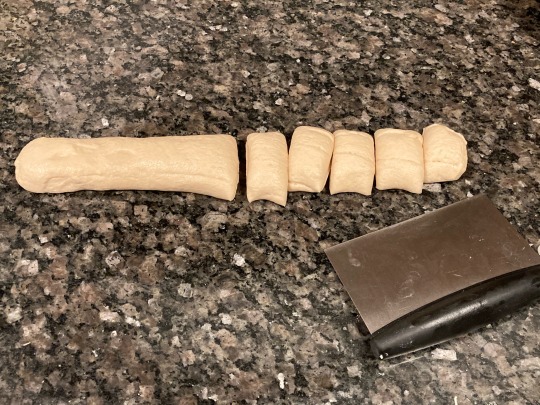
3. The folding method is the same as for baozi and momos. Hold a wrapper in the palm of your non-dominant hand and add a couple tablespoons of filling (if you’re not experienced with making dumplings, it may be easier to add less). While pressing the filling down with your non-dominant thumb, use your other hand to pinch pleated folds in the dough all the way around the circle of the wrapper. Remove your thumb and make one last fold to close the bao. Pinch firmly at the place where all the pleats come together (where the drawstring would be if it were a drawstring pouch) and give a small twist to seal.
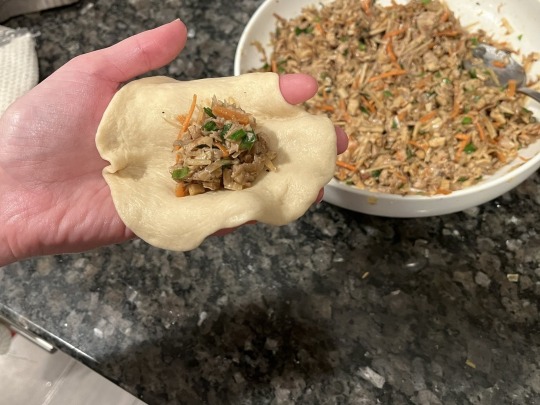
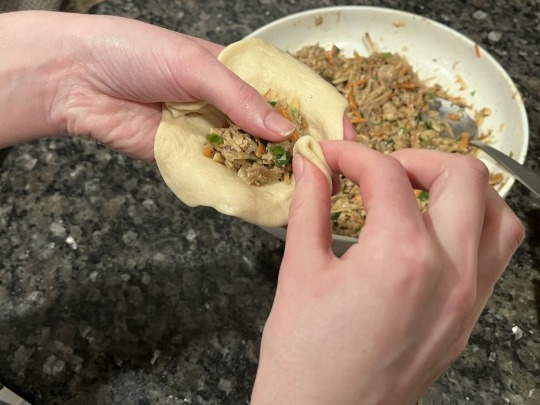
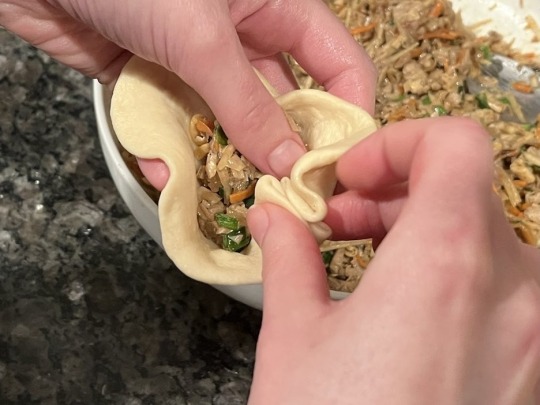


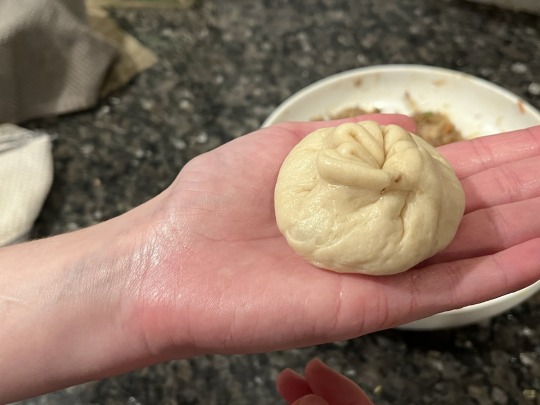
4. Set each finished bao on a small square of parchment paper on a baking sheet or in a steamer and lightly cover with plastic wrap or a light kitchen towel. Continue folding until you have formed all of the bao.
To steam:
1. Place a bamboo steamer in the bottom of a wok or large pot, and fill the wok with enough cool water to cover the bottom rim of the steamer by ½". If you've added baking powder to your dough, you may add a splash of vinegar to the water to help neutralise the dough's pH and combat yellowing of the dough.
If you’re using a metal steamer, tie a kitchen towel around its lid to prevent condensation from dipping back down onto the dumplings. Carefully place the bao, along with their parchment paper squares, into the steamer, leaving an inch or so between each one. They will expand as they steam!
If you don’t have a steamer, place a small bowl in the bottom of a wok or large, deep pan or pot. Place the dumplings, with their parchment paper squares, on a plate and place the plate on top of the bowl–the plate should fit inside your pot. Make sure that you can cover the plate and dumplings with a lid. If your lid is domed, there is no need for a kitchen towel, since the condensation will run down towards the outer rim. If your lid is flat, tie a tea towel around it just as you would with a metal steamer. Fill your cooking vessel with 2 or so centimeters of cool water.
2. Raise the heat to high and allow the water to come to a boil. Once boiling, lower the heat to medium-low and cover your steamer or pot. Steam the dumplings for about 8 minutes, until the dough is tender and cooked through. Keep finished bao warm in a covered casserole dish in an oven on low while you steam the others.
#vegetarian recipes#recipes#vegan recipes#Vietnamese#dumplings#carrots#cassava root#tofu skin#mushrooms#sườn non chay#chả lụa chay#fish sauce#chives
238 notes
·
View notes
Note
obviously you can’t cook don’t know what a blog is etc etc. but in a universe where you did would you know of any recipes your alternate self posted which used leftovers or scraps? or alternatively making really good stock? many thanks
hm. if I ever cooked I think I would say something like—take
the peels, ends, and greens (if you haven't used them for anything else) of carrots
the ends, leaves, and outer stringy bits (if you're one of those people who peel them) of celery
tomato skins
mushroom stems
peels and trimmings of onions
peels and ends of garlic
skins and trimmings of ginger
the whites of green onions
stems of fresh, tender herbs (parsley and cilantro)
stems of woody herbs (thyme, rosemary), in moderation
trimmings from leeks, turnips, and fennel, in moderation
And simmer in enough water to cover for about an hour, with herbs or whole spices if you'd like (I generally include bay leaves, black or white peppercorns, cumin seeds, and coriander seeds), then strain. You can keep scraps from preparing meals over the course of a few days or weeks and freeze them in a bag or other container until ready to make stock; make sure each bag has a good proportion of different vegetables. Frozen scraps will only take 15-20 minutes of simmering to make stock.
Make sure that you scrub any vegetables whose peels you will be using for stock thoroughly. Scraps can be used for stock if they are wilted, but not if they are rotten.
Various places online will give you different ideas of what to include in stock and what not to bother including (there's a pretty comprehensive list here); as you do this over time you will no doubt have your own opinions about inclusions and ratios. Do not include cruciferous vegetables (broccoli, cauliflower) as they will make the stock unpalatably bitter. You may chuse to divide scraps in terms of what meal you plan to make with the stock (e.g. leave ginger, lemongrass, galangal peels &c. for an east Asian meal rather than, like, an Italian one).
Other things that can be done with "scraps":
The whites of green onions can be simmered alongside kombu/dashima when making Japanese dashi or Korean yuksu. Also reconstitute dried shiitake mushrooms in this stock to get flavourful mushroom water in the stock + reconstituted mushrooms that you can slice, boil, fry, &c.
The whites of green onions can also be used to make shiraga negi, a Japanese garnish
Thai recipes often involve leaving the peels on garlic when chopping or pulverising it. I'm not sure how the skins on Thai garlic compare to other varieties so your mileage may vary.
Garlic and onion peels can be dried in a dehydrator or an oven on low (~200F) and then ground to add savor to bread, soups, rice &c. Basically use it like garlic powder
Cauliflower and broccoli stalks can be peeled, sliced and roasted (along with the leaves) at around 400F (200C) for 20 minutes or so until browned and crispy with olive oil, salt, and spices of your chusing, then dipped in ranch or garlic sauce (for a quick vegan ranch I mix vegan mayonnaise + grated garlic + a squeeze of lemon + pinch of salt).
Kale stems can be pickled, or sliced thin, sauteed, and added to stir-fries and soups.
The inner core of cabbages (which some recipes call for you to remove) can also be minced and added to soups.
Orange, lemon, and grapefruit peels can be used to make mixed peel; apple peels and cores can be used to make apple jelly. These recipes aren't really something-for-nothing, though, as they do use a lot of sugar.
Also orange peel tea. Sometimes when making mixed peel I drain the water after five minutes of simmering and drink it as tea, then replace the water and continue simmering as the recipe calls for.
Some Medditerranean cake recipes involve (perhaps soaking and then) blending an entire orange, peel and all--look up "whole orange cake."
When not making mixed peel, I (remove the pith from and then) dry orange and lemon peels to grind into zest and store it to use as needed. A friend of mine saves the pith, too, and dries and grinds it and uses it to replace some of the flour when baking.
South Indian & Latin American recipes sometimes feature the peels of bananas or plantains—look for banana peel curry/thoran.
Various recipes can be found for banana peel pulled pork and banana peel bacon; banana peel cake; banana peel tea.
Starch left from rinsing rice can be used to thicken soups and stews (this is common in Korean recipes).
The water left from cooking dried beans can be used in soups and stews, or in cooking future batches of beans.
Make sure that anything you're eating or boiling has been washed well.
I— I'm. uh. huh. that was weird, I don't know what came over me...
100 notes
·
View notes
Note
Hey, since cloning technology is good enough for them to create mammoth meatballs but not the entire mammoth yet, which prehistoric animal do you feel like taking a bite of?
Given where I was born, and where @dduane and I currently live, I think some Giant Irish Elk venison would be about right.

Enough for the entire clan with plenty of leftovers and a Handy Thing To Hang Stuff From.
*****
Which leads via Memory Lane to a funny by John M. Ford, who used to post such things - along with witticisms, wise observations and poetry - on Making Light.
He produced these in the same way a bonfire produces sparks: random, unexpected, brilliant and without apparent effort - though like the graceful swan on the river, I bet there was a lot of work going on out of sight. Or maybe not. Mike was that good.
For instance, he wrote THIS just to comment on another post...
I saved everything I could find offline because You Can Never Tell about online stuff, and also because there was, for a time, doubt - happily, It Got Better - that ANY of his writing would ever be seen again.
(Dammit, just like Terry Pratchett I HATE having to refer to Mike in past tense...)
And now, the funny (original archived Here). I've been assured that This Recipe Will Work, though the assurance also came with a strong suggestion about reducing the ingredient quantities More Than Somewhat.
*****
Hot Gingered Pygmy Mammoth & Jumbo Shrimp Salad
Feeds your whole tribe.
1 pygmy mammoth, boned and cubed (about 1 ton)
1 ton jumbo shrimp, peeled and deveined (many many ordinary shrimps, or one Ebirah claw)
10 buckets sesame seeds
60 pounds bean thread noodles if you are an Eastern tribe, whatever your tribe uses for noodles otherwise. If you have not yet invented the noodle, this might be a good time to do so.
1 bucket vegetable oil
1 bucket sesame oil
Salt
10 buckets minced fresh ginger
6 buckets minced garlic
15 buckets dry Sherry
15 buckets rice wine vinegar
60 pounds sugar
60 buckets diced fresh mangoes
15 buckets chopped green onions
Big Snorgul's helmet full of red pepper flakes
10 buckets chopped fresh cilantro, plus 5 Big Snorgul's helmets fresh cilantro, garnish
1000 large heads lettuce, cored and leaves separated (a raid on the People Who Grow Stuff may be necessary)
30 buckets thinly sliced, peeled, seeded, drained cucumbers, or just chop up the damn cucumbers and say "Fie to thee!" a lot
All the chives you got
Preheat a giant turtle shell over a fumarole. A big giant turtle. Put some oil in there. Make sure no other giant turtles are around to see you do this.
On a flat rock, stirring with your Stick of the Dining God, dry cook the sesame seeds over medium heat until they are brown and smell good. Remove from the heat. Add the noodles to the turtle shell and fry fast until puffy and the color of sunrise. Remove from the oil and drain on non-itchy leaves. Throw salt. Set aside.
Sear the mammoth meat on the flat rock. Salt but don't overdo it, you remember what happened to the Chest-Clutching Tribe of the Plains. Drain.
Get a less giant turtle shell. Okay, think of this as a celebration dish for a good turtle hunt and shrimp catch. Make the vegetable oil and most of the sesame oil dance. Add the shrimp, mammoth, ginger, and garlic, and cook fast, stirring, until the shrimp are just pink and firm. Doom of Ten Thousand Wretched Canapés awaits those who overcook shrimp. Remove from the shell with pole weapons. Add the sherry and vinegar, and sing the Song of Deglazing over medium heat. Add the sugar and stir until it is one with the sauce. Cook until half the fluid is gone. Feed anybody who thinks this is waste to the giant turtles. Add the rest of the sesame oil, mangoes, green onions, and pepper flakes, and stir to warm through and wilt. No, this wilt is good. Tell the people it is the wilt of the Wilt God. You need all the mojo you can get. Remove from the heat and add the shrimp and ginger, and the cilantro. Stir to warm through and do the Highly Dramatic Ritual of Adjusting the Seasoning to Taste.
Now your tribal status is on the thin edge of the cleaver. Have everybody bring what they eat off of. You know your tribe. Put lettuce on whatever they hold out and spread the hot stuff on it. Those who have no eating platters should be used to the drill by now. Arrange cucumber slices on top in whatever symbolic pattern seems propitious to you and sprinkle with the toasted sesame seeds. If you have a really tough tribe, yell "Bam!" until they get a groove going. Add fried noodles, cilantro sprigs, and chives, and watch for any signs of people keeling over that can't be blamed on strong drink.
#prehistoric animals#edible archaeology#irish elk#pygmy mammoth#john m. ford#gnu terry pratchett#recipes
145 notes
·
View notes
Text
Japanese Curry (1 spoon)
I’m pretty sure anyone who reads this thing is probably thinking that I have a thing for curry. Said ‘anyone’ would be right, particularly now that I’ve discovered how relatively easy it is. Japanese curry is one of my favourites - it’s not insanely spicy - there’s kick, but not enough to distract from some of the subtle flavours in it. Most people who see it on restaurant menus see it with katsu of some description, but while I do plan to learn how to make gluten-free katsu someday, it’s not necessary. Japanese curry is basically just a kind of somewhat spicy stew, and you can use effectively anything you like in it.
There are a lot of complicated recipes for Japanese curry online, and that’s even disregarding the ones that ask you to make your own curry roux. While I do also plan to try that sometime, I thought I’d start simple this month and see if I could find gluten-free curry roux to get me started. My Google-fu is strong enough that I found gluten-free curry roux from a company called Emma Basic, which does a variety of speciality Chinese and Japanese items. So the plan was Japanese curry by one of the online recipes I found sometime this month. So if you’ve got gluten intolerances, it’s worth a look. (Though it’s a London-based company so unless you’re in the UK, probably better to look for a place like it in your area.)
Today, though, was a very bad pain day in an increasing line of very bad pain days. I didn’t want tandoori chicken three nights in a row, and I also wanted comfort food, which Japanese curry is for me. But all the recipes I found looked too complicated. So I decided to read what it said on the packet ... and that looked a lot easier. So I did that instead, and while I still hurt, I can’t be too depressed when I’m full of the first Japanese curry I’ve had in years. So assuming that any curry roux will work the same as the stuff I got, let’s start. There are going to be a lot of notes because I’ll go over what I did but there’s a lot of wiggle room to address.
Here’s what you’ll need
Curry roux
Two potatoes, cubed
Three carrots, chopped
One large onion, cut into eighths
Two chicken breasts, cubed
Note: what the box actually said was “use whatever leftover vegetables are in your fridge”, but living alone and being disabled means fewer opportunities to keep fresh vegetables in the house. So I bought the veggies I’ve had in Japanese curries before, but you can use basically anything. I might try cauliflower next time. You don’t have to use chicken either; prawns, pork, beef (so long as it’s not stewing meat or anything; that would take too long to cook), tofu, just stick with the veggies by themselves - whatever you like.
Here’s what you do:
Pour a little bit of oil (maybe 2 tablespoons) into a casserole pan or other deep pan. Add the vegetables and chicken and heat on medium high heat for 2-3 minutes or so
Add water - enough to more or less cover the ingredients. Bring to a boil, cover and simmer for 10 minutes.
Add your curry roux in whatever form you’ve found it and stir until it’s fully blended (it should be opaque, a faintly-orange tan colour and about the consistency of whole milk). Simmer for another 5-10 minutes, stirring occasionally, until the mixture thickens a bit (so maybe the consistency of single cream).
Serve with rice
This is one of those ones that it’s actually hard to make any easier, just because the instructions are so basic. It’s little things like:
Already-cooked meat and vegetables will probably work as well as raw; you probably just don’t need to simmer them as much. You should still simmer them a bit, though, as that’s what helps get the flavour of your ingredients into the water, which further flavours the roux.
You could probably use frozen vegetables with this; you’d just have to defrost them first. Just put them in a bowl of cool water for a few minutes, then drain well.
Less a way to make it easier and more a thing to personalise it more - I spiced up the chicken a bit before I started heating everything. Just a little soy sauce, some coriander powder, some garlic puree and a bit of salt, but it gave the chicken a bit of extra niceness. So it’s worth a try if you have the spoons for it.
There we go - this serves about four, so it’s good for company, families, or just if you want a lot of leftovers to tide you over. One of these days, I will try a Japanese curry from scratch, or with some of the more complicated recipes, but for now, I managed one of my all-time favourites when I barely had enough spoons to remember to take my meds, so I call this one a win.
19 notes
·
View notes
Text
Magical Recipes; how to approach an established recipe as a Kitchen Witch
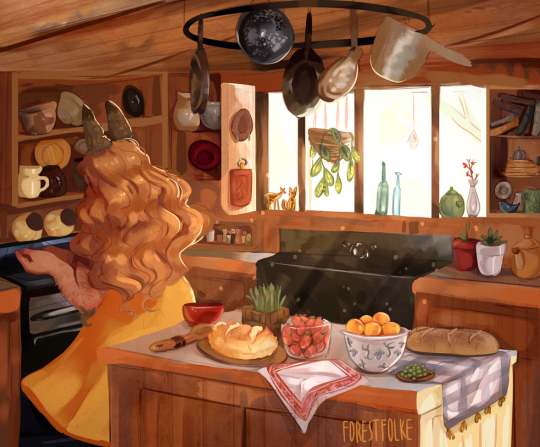
Art by forestfolke on Deviant Art
I think one of the most confusing things for new, or even experienced, kitchen witches is how to expand their recipe catalogue for their practice. A lot of new kitchen witches think you need to follow a recipe that has been written special for Witchy Cooking. That the regular recipes they find or use just won't have any magical purpose. But that's just not the case.
You don't need to buy special cook books with recipes exclusively for Kitchen Witches. You can take any recipe that already exists and apply it to your wants or needs. To help explain this process, I'm going to take a recipe I found online then reverse engineer it into a Kitchen Witch Recipe.
The Recipe
My Partner often donates blood, so eating foods that keep his Iron up is important to us. But I also want this dish to be emotionally satisfying Vs just eating a Steak, which neither of us find particularly appealing. I thought I'd try a Cottage Pie (also called Shepperd's Pie) because I want to find a new recipe that will help use up ingredients. Don't get me wrong, soups are awesome; but I tend to go a little light on the meat/alternatives. I tend to keep a good supply of ground meat in the freezer, so know I'll have most of the key stuff.
So I'm starting with this recipe since I don't have my own Cottage Pie recipe. Here are the Ingredients:
Filling
1 lb lean ground beef
1 lb ground sausage (I use Jimmy Dean pork sausage)
1 teaspoon salt
1/2 teaspoon freshly ground black pepper
1 small yellow onion , chopped
2 ribs celery , chopped
1-2 carrots , chopped (about 1 cup)
3 cloves garlic , minced
1/4 cup all-purpose flour
2 1/2 cups low-sodium beef broth
2 tablespoons tomato paste
1 cube beef bouillon
2 tablespoons Worcestershire sauce
1 teaspoon fresh thyme , chopped (or ¼ teaspoon dried thyme)
1 teaspoon fresh rosemary , chopped (or ¼ teaspoon dried rosemary)
2 bay leaves
½ cup frozen corn
½ cup frozen peas
Topping
2 1/2 pounds Russet potatoes , Yukon gold or russet potatoes
¼ cup sour cream
½ cup milk
4 tablespoons butter
salt and pepper , to taste
½ cup freshly grated parmesan cheese
½ cup shredded cheddar cheese , for topping
So let's start with the topping since it has less ingredients to worry about. For those unfamiliar with cottage pie, the base of the pie is mostly meat and Veggies, and then it's topped with some mashed potatoes before baking. It's common to just use leftover mashed potatoes. So, I'll just use my mashed potato and cauli recipe. In short, it's half potato and half cauliflower with roast garlic and seasonings.
Both Potatoes and Cauliflower have protective properties. Since this is the protective top layer of the Pie, I thought the symbolism carried itself further. The Cauliflower will also work well together with the Garlic to Banish any negativity from the pie, as well as from those who consume it.
Now let's break down the filling. Starting with the largest Ingredients.
Ground Beef and Ground Sausage. Ground meats in general are fantastic for grounding energy. I'll probably sub the ground beef for whatever ground meat I have on hand, so the grounding aspect is what I'll focus on for now. Potatoes are also good for grounding. This is over all is going to be a very down to earth, hearty meal.
Next, the vegetables.
Onion, Celery, Carrots, Peas, and Corn.
Corn is not something I use on the regular, but it's has a good use in Kitchen Magic as a power multiplier. Similar to Rice.
Carrots have heath and energy properties, something I want in a dish for improving Iron Levels.
Though I never particularly enjoyed peas, I'll use them for their health and abundance benefit. Green Peas are also high in Iron.
Celery is great ingredient to add to a dish to add lasting happiness and satisfaction. Which I defiantly want so when the dish is consumed, you don't feel disappointed.
Onion will add onto the Protection and Health. But Onion also has good cleansing properties, so I have the habit of adding it to my pan first to cleanse my cooking station. I'll probably cook some or all of the onion with the meat.
Now the Seasonings.
Not everything used in your cooking needs to have a magical purpose. It can just be there to enhance the taste of your food. I use Worcestershire sauce often in my cooking with no thought to it's magical abilities. I use it all the time when I want to add some extra umami or savory flavour. But there are some things we can add to help enhance the magic.
Thyme, Rosemary, and Bay.
All three of these herbs are good for health and healing. I can feed this to my SO before a donation to make sure his Iron is up. Then I can feed it to them after when their body is recuperating. Though I may forgo the Bay leaf. I tend to worry I'll leave it in my food when it's not supposed to be eaten XD
But that said, I think I'll add a few of my own.
Marjoram seems like it will go well in this, which will add to the Happiness and Comfort of my meal.
I wanna add some Basil and Cayenne to this. The Basil I'm hoping will help stop long term fatigue, so my SO's mind is not affected by the donation. Cayenne for a blast of extra energy.
I'll also add some extra Garlic and Parsley.
I'll also make a few other personal tweaks like swapping the Flour for Cornstarch. I prefer using corn starch in my sauces, and I already have corn as an ingredient anyway, so it should mesh together better on their property levels.
Cooking/Assembling
Now that I have the magical properties of all my ingredients established, I simply need to assemble them according to the recipe directions. The only difference is, when I add something to the dish, I know what I'm adding not only on a Mundane level, but also the magic properties of the food.
I'm adding ground meat to ground my dish and the people consuming it. I add Celery to help the food be emotionally satisfying. I'll add peas to enhance health and healing. Ect.
Also note, you don't need to do as big of a dissection every time you want to cook a recipe as a Kitchen Witch. If you come across an ingredient or two you are familiar with the magic properties for (Or the ingredient just has a spiritual meaning to you personally) You can add it to your meal with that meaning in mind. Like adding a little honey to your tea to sweeten and brighten your day.
Also note, most ingredients have multiple magical uses. Just as they have multiple culinary uses. You can add honey to tea for happiness, or may may choose to add it help heal and get over a cold you have. Or you can add it for both reasons! Or neither reason; maybe you just want some honey.
You are the Castor, the Decider, the Kitchen Witch!
Eat well and be well 💜💜💜
#food and folklore#klickwitch#kitchen witch#kitchen witchcraft#witch#cottagecore#cottage pie#Shepperd's pie#recipe#witch cooking#food meanings#magic properties#food#yum#pagan#recipes#magic#practical magic#cooking
6 notes
·
View notes
Text

The Real Cost Of Convenience
The other day I went through my weekly flyers, did some online snooping, and made a list of all my local deals that would help feed my family healthy fresh foods on the limited budget we have. We've been trying to feed our family of 3 whole foods and proteins for less than $100 a week. What started as a simple hunt for sales to stock up, ended up turning into a huge eye-opening lesson on convenience and our health. Please let our family's shopping trip and findings not only inspire you to eat healthier at a lower cost, but also open your eyes on the real cost of convenience on our health and wallets.
To summarize my findings, it turns out that we could buy over TWO TIMES the amount of vegetables that would feed us for a month (or more) STILL for less than opting for convenient, already-prepped frozen veggie alternatives. I spent $33.61 on fresh veggies to chop up and freeze, and after some research, the cheapest alternatives listed online equaled out to $75.64 for a nearly identical amount of frozen veggies (I accounted for the veggie waste difference). Which means I am cutting my vegetable grocery bill in half! That is absolutely insane. Keep in mind this amount of veggies would feed my family of 3 for a month at the price and amount I've already spent. Which means I could get about 2 months of food for my family for the price of 1 month of convenient, frozen options. This leaves us so much more room to invest in quality grass-fed red meat and pasture-raised poultry, so we can elevate our health and diet without spending more out of pocket. So, if you would like more affordable and healthy options for food in your house, I highly recommend looking for deals on fresh vegetables and stocking up when you are able to, rather than opting for the easy to grab and prepare option off the shelves. Eating healthy does not have to be expensive and is actually really affordable for families. Your health and wallet will thank you.
I plan to do more cost comparison and snooping around to see what else I can uncover and tips that I can give you all to elevate your lives in the future, but for now, here is a breakdown of where I shopped and what I spent, versus the cost of the cheapest convenient, frozen options of similar poundage online (after processing to account for veggie waste):


#cooking#food#healthy#lifestyle#whole foods#healthy food#budget#budgeting#tips#tricks#money#momblr#mom life#family#family life#meal prep#meal prepping#money saving#simplistic#simple life#rustic life#cottagecore#glow up#traditional#basic#freezer#food prep#meal#healthy meals#whole food plant based
2 notes
·
View notes
Text

Chicken of the Woods Recipe
'Chicken', Leek, and Mushroom Pie
Chicken of the Woods (Laetiporus Sulphureus) is one of summer’s most exciting and unmistakable finds. With its distinctive bright yellow-orange colouring and characteristic globular shape, this is a great beginner mushroom for anyone just dipping their toes into mushroom hunting. It goes without saying though: never eat a mushroom that you haven’t confirmed the identity of using several sources.


Chicken of the woods is a bracket fungus that grows on trees and dead wood. Every specimen I’ve found has been on a beautiful gnarled old oak tree, but they can also grow on cherry, sweet chestnut, willow, and yew. Take care when collecting and pay attention to where they’re growing. Fungus growing on yew can take in toxins from this poisonous tree, and I’ve heard that the occasional specimen on old fence posts can have the same issue with substances used to treat the wood. Be careful and only collect specimens from deciduous trees and stumps.

When picking chicken of the woods, the younger the better. Small fans with bright yellow colouring and rounded edges are in their prime. At this stage, the fungus is a choice culinary delight, with a soft texture similar to chicken- hence the name. As they age, COTW grow into large fans with wavy edges, becoming pale and dry. Once this mushroom is past its best, it has a texture more akin to polystyrene than juicy chicken!
You can find plenty of recipes online for making meals out of chicken of the woods, often capitalising on its namesake as a veggie replacement in dishes traditionally made with white meat. Lots of recipes include breading and frying, which cotw lends itself well to.

The recipe below is another foraged play on a British pub classic- chicken, leek and mushroom pie. Though it seems a little excessive (this is actually a mushroom, leek, and more mushroom pie!) the addition of other mushrooms is important to the flavour. As well as having a texture similar to chicken, cotw tastes similar to chicken too- which is to say that it tastes of very little at all. You can use any other kind of mushroom you like, but the best would be those with a strong, mushroomy flavour. I’ve used dryad’s saddles, but some good foraged alternatives would be parasols, field mushrooms, or any kind of edible bolete. If you rehydrate dried mushrooms to use in this recipe, you can replace some or all of the stock with the mushroom-soaking liquid for extra umami!
Chicken of the Woods, Leek, and Mushroom Pie Recipe.
Ingredients
For the Pastry:
80 grams salted butter
80 grams lard (substitute with more butter to make this recipe vegetarian)
500g plain flour
1 egg, plus one for glazing
For the Filling:
500g fresh chicken of the woods mushroom
2 large leeks
200g other mushrooms (rehydrated weight if using dried)
3 cloves garlic
5tbsp plain flour
200ml chicken or vegetable stock
200ml full-fat milk or single cream
1 handful chopped fresh parsley, or 2 tbsp dried
1 handful chopped fresh tarragon, or 2 tbsp dried (optional)
1 tsp craked black pepper
2tsp mustard powder, or 1tsp English mustard
1/2 tsp paprika (optional)
White wine, white wine vinegar or apple cider vinegar for deglazing
Butter for frying
Method:
Make the pastry using a hot water crust method. Measure out your flour in a large heatproof bowl. Crack the egg into the centre and use a butterknife to stir it into the floure. Heat your fat(s) gently in a saucepan with 200ml cold water until melted. Allow the liquid to cool for a minute or so, then tip into the middle of your flour/egg mixture. Stir quickly with your butterknife to combine. Tip the dough out onto a surface and knead very briefly until smooth. Wrap tightly and place in the fridge to cool for at least an half an hour.
Heat a large knob of butter in a saucepan over a medium-high heat. Clean your chicken of the woods mushrooms and slice away any bruised or soft areas. Cut the rest into small bite-sized chunks. Slice your other mushrooms thickly (if using rehydrated, drain off as much liquid as possible). Throw everything in the pan and fry, stirring frequently, until thoroughly browned.
Thickly slice the leeks and mince the garlic. Once the mushrooms are browned, turn the heat down to medium-low and add the leeks with the garlic. Fry for a few minutes until starting to colour. Deglaze the pan with a splash of wine or vinegar, then add the mustard, pepper, and paprika (if using) to the pan and stir.
Turn the heat to low. Add the flour and stir through evenly, so all the filling is coated. Very slowly pour in your stock, stirring constantly, allowing the flour to absorb all the liquid you've poured in before adding more. Once all the stock has been added, pour in the milk/cream and stir again. Stir in the herbs and allow the mixture to simmer gently for ten minutes, stirring occasionally, until thickened.
Preheat your oven to 190 degrees (fan 170, gas mark 5). Lightly grease your tin. A large, flat tart tin works, but I've used a deep 9-inch cake tin to give the pie a little height. If making a deeper pie, split the pastry into two pieces of roughly two thirds (for the bottom) and one third (for the top). If making a flatter pie, split it roughly in half.
Roll out your bottom piece of pastry into a rough circle big enough to cover the bottom and sides of your dish. You shouldn't need to flour your surface, but you can do so if your pastry sticks. Place the rolled out pastry into the tin and gently press into the sides. Pour the filling into the pie crust.
Beat an egg in a small bowl with a splash of milk. Brush a little of this eggwash around the lip of the pie crust. Roll out the top piece, and place it on top. Use your thumb and forefinger to crimp the edge, then slice off the excess pastry with a sharp knife. Use the offcuts to decorate the top if you're feeling creative, and slice some lines to allow steam to escape. Then brush the top off the pie with more eggwash.
Bake for about an hour, or until golden brown on top. Let the pie cool for ten minutes or so after removing from the oven so it holds its shape better when sliced. Eat as it is, or try it with roast veg and a homemade mushroom gravy!
#foraging#mushrooms#chicken of the woods#chicken of the woods recipe#wild food#wild food recipe#foraging recipe#bracket fungi#recipe#laetiporus sulphureus#pie#vegetarian
13 notes
·
View notes
Text
Sacramento Waterboy Review
WHAT WE ATE:
Drinks:
A glass of some kind of Pinot Noir
a "Tequila Honeybee" (??)
a "Hemmingway's Daiquiri" (??)
I'm not 100% certain on the names because I cannot find the cocktail menu we had online.
First course:
Bruschetta: Toasted Focaccia, Burrata, Roasted Local Stone Fruit (We Had Peaches and Cherries), Watercress, Basil, Balsamico
Cheese Plate: Selection of Four Cheeses with Toasted Bread, Crostini & Olives
Seasonal Vegetables (Heirloom tomato)
Main course:
Sonoma Liberty Duck Breast “Panzanella”: Toasted Focaccia, Local Cherries & Grilled Peaches, Arugula, Glazed Spring Onions, Balsamico
Mixed Grill of Lamb Chop, Quail & Bacon: Tomato-Eggplant-Zucchini Gratin, Crispy Fresh Corn Polenta, Rosemary-Shallot Jus
Dessert:
Summer Fruit (Strawberry) Crostata with Housemade Vanilla Bean Ice Cream
Affogato: Warm Pachamama Espresso Served Over Housemade Vanilla Ice Cream
I had the Duck and the Affogato, so I can not give a proper review of the "Mixed Grill" or the Crostata, though I did have a nibble here and there.
THE COCKTAILS
We were seated outside on the patio and although it was the early evening and still hot, it was quite nice because they had misters (??) spraying mist essentially directly on us, at least until some troublesome trout WASP women came in during the main course and had it turned off. We started off with the cocktails. Let me be frank, and do not let this tarnish your view of the establishment as a whole: they were mid. Despite, nay, because of the many ingredients that went into each one, they were extremely one-note and surprisingly acidic. The creator of these drinks clearly believed in cocktails being boozy, and boozy they were, but they were so at the cost of taste; my Honeybee did not taste of honey at all, but luckily I am a fan of raw tequila, so I wasn't too mad. My heartburn, however...
FIRST COURSE
Soon (the service here was very timely and friendly, a small but crucial sticking point when it comes to Finer Dining) we were served the First Course. We had ordered the bruschetta because the last time we had it, at the same seemingly ridiculous price point, it was Life Changing. Who knew that bread, tomatoes, and balsamic could be so damn good?
To my horror, the bruschetta had no tomatoes whatsoever. It was all peach hunks and cherry halves, sat atop a healthy serving of burrata (a good sign) along with some kind of herbs, many of which were entire leaves (I Do Not Like this, I wish restaurants and spring rolls would give up Entire Leaf as the means by which to give an herbaceaus flavour to the dish, it is too firm and fibrous compared to everything else in any given dish and therefore I am still stuck chewing it when all else has already been masticated and swallowed. It's disgusting. Stop.). The crostini was soaked with oil (butter?) and was delightfully crisp and greasy.
I'm on team Fruity Bruschetta now. It works. It's great. The sweetness and acidity of the fruit contrasts with the salty creaminess of the burrata, and then the crisp oiliness of the crostini brings it all together by giving you that delightful and drawn out crunch.
I'd be damned if I could remember exactly what the cheeses were supposed to be on the Cheese Platter, but they were some kind of Brie, some kind of French cheese that was aged in ashes (to be referred to as Ash Cheese), a Blue cheese that, we were told, had been aged in fig leaves soaked in whiskey, and a semi-firm that tasted very mild.
My personal favorites, in order from best to worst, were Brie, Ash Cheese, Semi-Firm, and the Blue. I have nothing to say about the semi-firm nor the blue, they were very generic for their kind and frankly, I have never been a fan of Blue Cheese or stinkies as a whole.
The brie was also fairly generic for a brie, but it was somehow extra Fine in its taste, perhaps because it was served at room temperature, as brie is supposed to be served, and not directly out of the fridge, as I tend to consume it.
The ash cheese had a strong, cheesey flavor, somewhat akin to a gouda, and was very appallingly gummy? It stuck to the roof of my mouth like it had decided it wanted to be peanutbutter, and a single bite of it took me several minutes to really swallow down. Tasted good though.
The platter itself did not have enough bread, so we resorted to eating cheese, particularly the non-offensive semi-firm, on the heirlooms. This was a delightful combo; always feel free to get creative with your meals, do not feel constrained by a chef's intents. Sometimes they don't know the correct cheese-to-crostini ratio. The almonds and olives in the centre were a nice touch, and the apricot (?) jam helped the blue cheese become something genuinely delicious rather than a painful, smelly chore. Strong cheeses are best when contrasted with something else. They did not give me enough of the jam, which is a shame.
The heirlooms were essentially a caprese salad without the mozzarella, and would've been only improved by the simple chopping of the herbs.
MAIN COURSE
I came out of the first course feeling extremely enthusiastic about the main course. After all, if all of the appetizers were stunning and lovely, how could the main course not be? But lord, have mercy...
My dinner was simple. Seared duck breast, sliced thinly and sat atop a simple arugula salad, accented with toasted focattia, slices of grilled peach, and cherry halves (a requiem of the bruschetta; these fruits are what's in season). Wonderful, except for one fatal flaw; the duck was rare. The skin was crisp, yes, and I know duck is a red meat, but...it was rare enough to be quacking. I am not bothered by this psychologically, but texture-wise...eugh. Chewy, gross, and because the inside is essentially uncooked, cold. Additionally, only the skin was seasoned, and in a very limited fashion, at that, so what would happen with each bite was much like the problem with using herb leaves as seasoning; I'd finish and swallow all the good stuff first (skin), then be left with the worst part last. This is where the wine comes in; I know that red wine and red meat are best buddies (if you don't know why, why are you even reading this?), so in a moment of brilliance I simply requested that the waiter give me whatever red wine suits the duck best. He gave me Pinot Noir. This, along with cutting the duck extra small and seasoning it further, saved the meal more or less, though I will not be ordering it again.
My dining partner's meal, the grill mix, was done much better in every conceivable way. I'm really, truly confounded as to how they can cook a lamb rib right but not duck breast. I tried every aspect of the meal except for the bacon, and the only complaint I had was that they oversalted the quail.
DESSERT
I ordered the affogato because none of the other desserts appealed to me (I was under the impression they'd have key lime pie, they did not) and the caffeine sounded nice. If you've never had this, simply make some espresso and pour it over a scoop of vanilla (ideally French vanilla) ice cream or gelato while it's still hot. Eventually, the whole thing melts into a tasty slurry of coffee and vanilla. You can also do what my mother used to do, and put a scoop of the same into a cup of regular coffee.
My only complaint is that the coffee was too sour; I really don't like sour coffee.
CONCLUSION
In my experience, a lot of restaurants do an amazing job with appetizers, but fumble when it comes to the main course. Black Angus and Lazy Dog both come to mind. I am not sure why this happens, but I will eventually return to Waterboy and give them another chance. After all, the apps were mind-blowing, and the only major issue (unrelated to my personal preferences) was the duck, which may very well have been an issue due to my muscle weakness making it difficult for me to chew. I often struggle with meats others don't consider to be tough, and this may have been the case. Also, their scallop and pork belly platter is calling my name.
2 notes
·
View notes
Text
Post Workout Breakfast Ideas for Your Busy Schedule
Workouts are tiring and demanding. Thus, we often crave something tasty as we return home after hitting the gym. Have you ever thought of eating something healthy and filling post-workout and refraining from munching on the same unhealthy snacks, but, you find it difficult to cook something in the hurry of your daily activities? So here we are to discuss some healthy recipes that can be made in no time to support your busy schedule. Also, to save additional time order fresh chopped vegetable delivery online. Now, without any further delay let’s dive into the significant, so you can have a healthy breakfast and start your day on time.

Healthy Post-Workout Breakfast Ideas
Protein Smoothies
Protein Smoothies are one of the best breakfast ideas. They require no time to make, are highly customizable, and are rich in nutrients. As they are versatile you can add or remove any of the ingredients, and here we are discussing one of our best smoothie picks- the spinach banana smoothie.
Ingredients:
· 1 cup plain kefir
· 1 tablespoon peanut butter
· 1 cup spinach
· 1 banana
· 1 tablespoon honey (Optional)
Process:
Put all the ingredients in a blender and blend until smooth. You can choose to add milk (as per your requirement), in case you want a more liquid consistency.
Fruit and Veggie Muffins
Muffins are great when you want to munch on something tasty. Also, by customizing the recipe you can make them healthy. These can be stored, making them the preference in your weekly diet list, as you do not need to cook them on the go, rather just grab them when you are off to work. So, here is our healthy muffin recipe.
Ingredients:
1 cup whole wheat flour
1 cup multi-purpose flour
1 teaspoon baking soda
1/2 teaspoon salt
1/4 teaspoon nutmeg
1/2 teaspoon cinnamon
1/2 cup sugar
4 tablespoons butter, unsalted softened
2 large egg
1 teaspoon vanilla extract
1/2 cup steamed broccoli florets
1 small shredded zucchini
1 1/2 medium finely shredded carrot
1/2 medium apple
1 medium banana
1/4 cup unsweetened applesauce
1/4 cup Greek yogurt, plain
Process:
Start the process by preheating the oven to 375 degrees F.
Then, take a medium-sized bowl to mix flour, baking soda, salt, nutmeg, and cinnamon, and set the mixture aside.
In another bowl, mix the sugar, softened butter, eggs, vanilla, and Greek yogurt. Beat well.
Then in a food processor, combine steamed broccoli, shredded zucchini and carrots, apple, banana, and applesauce. Grind until smooth.
Transfer the ground fruits and vegetable mixture into the bowl with wet ingredients and beat the mixture until the ingredients mix properly.
Pour the mixture into the bowl of the dry ingredients and mix just until combined and wet.
Spray the muffin tin with cooking spray or oil. You can also use silicone muffin cups.
Fill each cup about 3/4 of the way full, with the prepared mixture.
For minor muffins: Bake in a 375° F oven for 15-20 minutes.
For regular-size muffins: Bake in a 375° F degree oven for about 20-25 minutes.
Bake until the tops are slightly brown and a toothpick comes out clean or they bounce back when you touch them with your finger.
Mixed Vegetable Omelet
Omelet is rich in protein and you can make it extra nutritious by adding vegetables of your choice. We are sharing with you our recipe for a mixed vegetable omelet. However, the ingredients are highly customizable and can be changed as per your preference.
Ingredients:
· 2 organic eggs
4 small button mushrooms
· 1/2 cup of chopped spinach
1 small chopped tomato
1 small chopped capsicum(buy capsicum online)
1/2 cup of chopped lettuce (order fresh lettuce online)
1/2 finely chopped onion
1 finely chopped clove of garlic
1 tsp extra virgin coconut oil
1/2 tsp paprika powder
1/2 tsp mixed dried Italian herbs
· salt and ground pepper to taste
Process:
· Start by heating oil on a nonstick pan.
· Once the oil is hot add onion and sauté them until translucent.
· Then add chopped garlic and fry for a minute or two.
· Add the chopped mushrooms and sauté for 4 to 5 minutes until all the water evaporates.
Now add the tomatoes and fry for another 2 to 3 minutes
· In a separate bowl beat the eggs and season them with salt and pepper and the other spices.
Now spread the veggies around the pan, gently pour the beaten eggs all over the vegetables, and spread it evenly.
Cover the omelet and let it cook for 2 to 3 minutes.
Check the omelet to turn brown on the side of the pan and flip it over to cook it from the other side as well for a minute or two.
Your omelet is ready. Serve with a sauce or crusty bread and enjoy.
Order Chopped Vegetables Online in Bangalore Now
So now that you have the recipes for a healthy post-workout breakfast, do not wait to try them the next morning. You can considerably reduce the cooking time by ordering fresh-cut vegetables online. If you are searching for a credible platform, GreenChopper is one of the best-cut vegetable suppliers online in Bangalore. It offers fresh vegetable delivery in Bangalore, chopped in a variety of shapes and sizes. It is also known for providing healthy ozone-washed vegetable delivery in Bangalore. You can also try their vegetable salads for healthy evening snacks. So, do not wait, and visit GreenChopper now.
#fresh chopped vegetable delivery online#buy capsicum online#order fresh lettuce online#cut vegetable suppliers
0 notes
Text
One of the Best Hydroponic Leafy Greens in Delhi NCR | Inhydrogreens
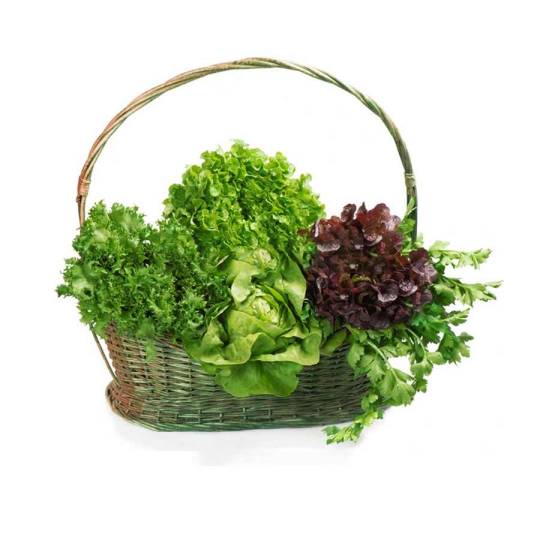
Leaf vegetables, also called leafy greens, pot herbs, vegetable greens, or simply greens, are plant leaves eaten as a vegetable, sometimes accompanied by tender petioles and shoots. Leaf vegetables eaten raw in a salad can be called salad greens.
Nearly one thousand species of plants with edible leaves are known. Leaf vegetables most often come from short-lived herbaceous plants, such as lettuce and spinach. Woody plants of various species also provide edible leaves.
#Buy Hydroponic Herbs Online#Buy Fresh Herbs Online#Mix Lettuce Box#Buy Online Microgreens Box#Buy Hydroponic Microgreens#Hydroponic Vegetables Online#Leafy Green Vegetables in Delhi#Fresh Herbs Online Delhi#Buy Chopped Vegetables#Chopped Vegetables Online#Hydroponic Vegetables in Delhi
0 notes
Text
Did you hear about the vegetarian who had a heart attack? Yeah, me neither. That's because studies have shown that vegetarians have a lower risk of heart disease than their meat-eating counterparts. In fact, according to Dr. Neal Barnard, a renowned physician and advocate for plant-based diets, "vegetarian and vegan diets can help prevent heart disease, and even reverse it in some cases."
So, why is a vegetarian diet so beneficial for heart health? Well, for starters, plant-based diets are typically lower in saturated and trans fats, which are known to raise cholesterol levels and increase the risk of heart disease. In addition, plant-based diets are rich in fiber, which can help lower cholesterol levels and reduce the risk of heart disease.

But don't just take my word for it. In his book "The Vegan Starter Kit," Dr. Barnard cites several studies that support the heart health benefits of vegetarian diets. For example, a study published in the American Journal of Clinical Nutrition found that "vegetarians had 24% lower mortality from ischemic heart disease than non-vegetarians." Another study published in the Journal of the American College of Cardiology found that "vegetarian and vegan diets are associated with a significantly lower risk of ischemic heart disease."
But what does a heart-healthy vegetarian diet actually look like? Well, it's all about incorporating a variety of fruits, vegetables, whole grains, and legumes into your diet. For example, you could start your day with a bowl of oatmeal topped with fresh berries and chopped nuts, have a salad with lots of leafy greens and colorful veggies for lunch, and enjoy a stir-fry with tofu and lots of veggies for dinner.
Of course, making the switch to a vegetarian diet can be challenging for some people. But Dr. Barnard offers plenty of tips and resources to help people make the transition. For example, he suggests starting with small steps, such as swapping out meat for plant-based proteins like beans, lentils, and tofu. He also recommends finding support from others who are also interested in plant-based eating, whether that's through online communities or local vegetarian and vegan groups.
And if you're looking for a little bit of humor to keep things light, here's a vegetarian joke for you: Why did the tomato turn red? Because it saw the salad dressing!
All jokes aside, the heart health benefits of a vegetarian diet are no laughing matter. So if you're interested in improving your heart health and reducing your risk of heart disease, why not give plant-based eating a try? With a little bit of creativity and some delicious vegetarian recipes, you just might find that you don't miss meat at all!
2 notes
·
View notes
Text

[ID: A bowl full of rice and a reddish, saucy stew with carrots, potatoes, and shredded chicken. End ID]
Vegan pollo guisado (Puerto Rican chicken stew)
Pollo guisado, a popular dish in Central and South America and the Caribbean, combines marinated and braised chicken with potatoes, carrots, and green olives in a tomato-based broth. This Puerto Rican version uses a recaito of onion, garlic, aji dulce peppers, and culantro to add savor and depth to the dish, while sazón lends spice and color.
Recipe under the cut!
Patreon | Tip jar
Ingredients:
For the chicken:
About 150g sườn non chay, or 300g ready-made vegetarian chicken substitute
Water plus 2 tsp vegetarian chicken stock from concentrate (if using sườn non chay or other dried meat substitute)
1 Tbsp vegetable oil (if not using sườn non chay)
1 Tbsp sazón
1 tsp garlic powder
1 teaspoon salt
1/4 tsp black pepper
1/4 tsp dried oregano
Sườn non chay ('vegetarian ribs') is a Vietnamese soy- and wheat-based meat replacement. It may be found in bags online or at your local Asian grocery–the bags will be labelled “sườn non chay” as well as “vegan meat slice,” “textured soy bean protein,” “vegetarian food,” or “vegan food.” I like it for its versatility and stringy texture, but you can use any vegetarian chicken substitute you have on hand, or even omit the chicken and increase the amount of carrot and potato.
For the recaito:
1/2 large white onion, chopped
1/2 head garlic, peeled and chopped
2.5 oz / 70g (5 medium) aji dulce peppers, chopped
1 oz / 28g (a few slices) mixed bell peppers, chopped
About 18 (1.5oz / 43g) culantro leaves, ends removed and chopped
1 small bunch cilantro, leaves removed
This basic mixture of peppers, aromatics, and herbs is a common base for many Latin American dishes, though its exact composition varies according to region and personal preference. Some would call such a mixture a "sofrito"—others will insist that it is a "recaito" until the tomato is added, at which point it becomes "sofrito."
Culantro is an herb related to cilantro but somewhat sharper in taste. It can be found at a Latin American grocery, or an Asian grocery that sells Vietnamese produce (where it will be called "sawtooth herb" or "ngo gai"). You may substitute more cilantro if necessary.
For the dish:
Extra virgin olive oil
1 Tbsp sazón, divided
1 tsp garlic power
1 bay leaf
1/4 cup recaito
4-5 tomatoes, diced (or 1 8oz-can tomato sauce)
1/4 cup Spanish olives
1/2 pound (2 medium) potatoes, peeled and diced into large chunks
2 medium carrots, cubed
2-3 cups vegetable stock, or vegetarian chicken broth from concentrate
2 sprigs fresh oregano, or 1/2 tsp dried oregano
Salt and ground black pepper, to taste
Instructions:
For the recaito:
1. Mash all ingredients in a mortar and pestle until a rough paste forms.
You may also use a food processor: process the onions for a few pulses, then add garlic and peppers and pulse again. Finally, process the culantro and cilantro leaves, in batches if necessary, until sofrito is the consistency of apple sauce.
For the chicken:
1. If using sườn non chay: whisk vegetarian chicken stock concentrate and spices (sazón, garlic powder, salt, black pepper, and oregano) into enough hot water to cover the sườn non chay in a cassrole dish or other wide, flat vessel. Soak sườn non chay for 10 minutes, until tender, then tear into small strips. In a large pot, simmer sườn non chay in their soaking liquid until the liquid has completely evaporated.
2. If using another chicken substitute: mix all marinade ingredients in a large bowl. Add chicken substitute and mix to coat. Refrigerate and marinate for half an hour while you prepare the other ingredients, or overnight.
For the recaito:
1. Mash all ingredients in a mortar and pestle until a rough paste forms.
You may also use a food processor: process the onions for a few pulses, then add garlic and peppers and pulse again. Finally, process the culantro and cilantro leaves, in batches if necessary, until sofrito is the consistency of apple sauce.
For the dish:
1. Heat 1/2 cm olive oil in a large pot on medium. Fry chicken, turning as necessary, until golden brown on all sides. Set aside.
2. Mix sazón, garlic powder, and black pepper with just enough water to form a thick paste. In the same pot you used to fry the chicken, fry the bay leaf and most of the spice mixture until water has evaporated.
3. Add the recaito and sauté for three minutes, until fragrant. Add tomatoes and allow to cook until mostly dry.
4. Add olives, potatoes, and carrots and stir to combine. Allow to fry for another couple minutes.
5. Add vegetable or chicken stock and remaining spice mixture. Raise heat to bring to a boil, then lower heat to a simmer. Cook until potatoes and carrots are almost tender. Add chicken and heat through.
Serve hot, over rice.
#recipes#Puerto Rican#vegan recipes#vegetarian recipes#carrots#potatoes#olives#chicken#culantro#stew#cooking#gluten free#depending on the chicken sub you use
106 notes
·
View notes
Text

Sen5es Recipe: Carrot And Coriander Soup
What's a better way to warm up in the winter months than with a nice bowl (or in this case jar) of soup?
We all know how convenient it is to buy a pot of soup from the supermarket. It's usually the right quantity for 2 people and it saves time and wastage. But what if you could make your own portion sized pots of soup?
The best way to store your soup, ready for individual portions is in some lovely glass jars. We have a wide range of glass jars in stock. But for this particular recipe we would suggest using our 277ml KilnClip Jar for a one person portion of soup.
These jars are great for storing soup as they have a strong air tight seal and look fabulous in the fridge. The following recipe will create around 5-6 jars. From our online store you can buy a pack of 6 for just £9 plus shipping. That way you will always have an extra jar just in case. And the best thing about these jars is that they are reusable! Perfect for an eco-friendly and decorative packaging solution.

Ingredients
50g butter
450g carrots, peeled and chopped
1/2 onion, chopped
1 celery stick
30g plain flour
1 glass of wine (optional)
1 L vegetable stock
1 tsp ground coriander
30g Fresh Coriander
100ml whipping or double cream
Equipment
Knife and chopping board
Large Saucepan with lid
Blender/food processor
wooden or silicone spoon
Ladle
6 x 277ml KilnClip Jars (sterilised)
Method
Heat your butter in a large pan and add your onion and celery. sweat on a low heat for around 2-4 minutes or until it's softened.
Add your ground coriander and carrots and cook for a further 2-3 minutes.
Add your flour and stir well.
Add wine (optional) and vegetable stock and bring to the boil.
Reduce your heat and cover. Cook for around 30 minutes or until the carrots are tender.
Pour in to your food processor with your Cream and fresh coriander and then blend it until it's smooth.
Allow to cool and ladle in to your sterilised glass jars. Check out our sterilisation guide if you need help with this!
Seal and store in the fridge until ready to eat. These should last up to 4 days sealed and in the fridge, to keep for longer freeze for up to 3 months.
To reheat pour the contents in to small sauce pan and gently heat for 5 minutes.
Please note: There is metal in the closing mechanism of the jar and therefore it is not suitable to be used in a microwave.
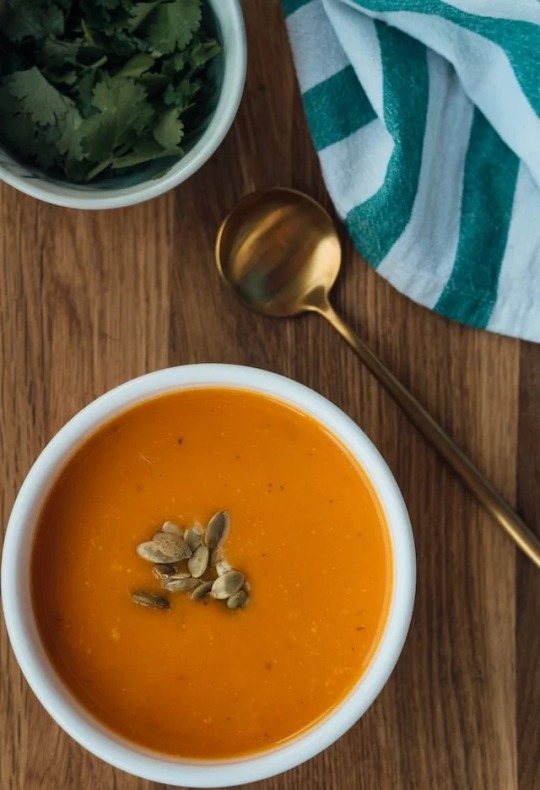
(Photo credit: Hanna Balan on Unsplash)
What do you think of this delicious soup? Will you be storing your home made soup in some lovely and decorative glass jars?
Don't forget you can keep up to date with all the latest news at Sen5es by following us on Facebook, Instagram, Twitter and TikTok You can also tag us in your product shots to show off how you use our amazing Glass Jars!
All the best
The team at Sen5es
#glass#glassjar#soup season#soup recipes#recipies#cooking#sen5esproducts#blog post#new blog#goodfood
2 notes
·
View notes